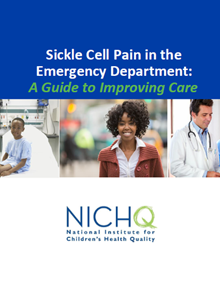‘How To’ Guide Available to Help Sickle Cell Disease Patients in the Emergency Room
 NICHQ today announces “Sickle Cell Pain in the Emergency Department: A Guide to Improving Care,” a step-by-step manual for anyone on the front lines of acute care, from emergency room (ER) doctors and nurses, to hematology specialists. The guide, launched on World Sickle Cell Day, is the result of a five-year collaboration between 15 multidisciplinary healthcare provider teams nationwide. Throughout the process, teams traded lessons learned and best practices for improving treatment for adults and children with sickle cell disease (SCD) in the ER.
NICHQ today announces “Sickle Cell Pain in the Emergency Department: A Guide to Improving Care,” a step-by-step manual for anyone on the front lines of acute care, from emergency room (ER) doctors and nurses, to hematology specialists. The guide, launched on World Sickle Cell Day, is the result of a five-year collaboration between 15 multidisciplinary healthcare provider teams nationwide. Throughout the process, teams traded lessons learned and best practices for improving treatment for adults and children with sickle cell disease (SCD) in the ER.
An inherited red blood disorder, SCD is a chronic illness characterized by anemia and unbearable bouts of pain, so providing relief quickly is crucial to treatment. This incurable disease can lead to declining health, poor quality of life and early mortality. NICHQ Strategic Project Director Suzette Oyeku, MD, said, “Sickle cell disease patients wait in excruciating pain longer than they have to for treatment. Guidelines do exist, but they have not been consistently implemented, particularly in acute care settings. Our guide was designed to help providers bridge this gap.”
NICHQ’s SCD work was funded by The U.S. Health Resources and Services Administration (HRSA) which oversees the SCD Treatment Demonstration Program (SCDTDP) and the SCD Newborn Screening Program (SCDNBSP). NICHQ served as the National Coordinating Center for the SCDTDP from 2010 to 2014 and National Coordinating and Evaluation Center from 2011 to end of May 2015. NICHQ was responsible for organizing and reporting on meetings; collecting, analyzing and distributing best practice data; and serving as the liaison between HRSA and the teams. The two projects yielded many results in improving care for SCD patients in the ER. These included a reduction in the wait time for evaluation by 69 percent and a 29 percent improvement in the time between triage and receiving pain medication. One of the most significant outputs of the teams’ extensive work is “Sickle Cell Pain in the Emergency Department: A Guide to Improving Care.” The online publication offers best practice findings such as standardized order sets, a recommendation to consider using intranasal fentanyl and a color-coded, full body chart, reviewed by patients and doctors, as a standard pain assessment tool.
According to HRSA Project Officer E. Donnell Ivy, MD, MPH, NICHQ and the Treatment Demonstration and Newborn Screening program grantees have pulled together an excellent resource. He said, “On World Sickle Cell Day and as Sickle Cell Awareness Month approaches, the timing for sharing this comprehensive guide could not be better. We congratulate NICHQ and all of our grantees on advancing the quality of care for these patients. As a result of their work, thousands of patients, from coast to coast, will receive better treatment in the ER.”
NICHQ has developed other SCD resources such as videos, journal articles, screening tools and fact sheets for health care providers and consumers.
